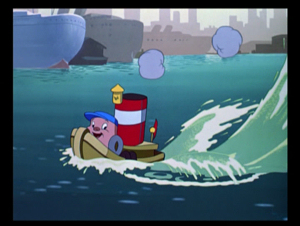 |
| (c) Disney |
watched August 5, 2012
Chicken Little is one of those familiar tales that has a variety of names and outcomes, with a single element that threads them all together, the famous adage: "The sky is falling!"
But Disney's 2005 version (there was a 1943 Disney short of the same title) veers rather far from the original folk tale, taking a sci-fi spin (yup, more aliens) and adding pop culture-y humor. While the alleged falling sky plays a key role in the plot, Chicken Little is less of a warning not to believe everything you hear, and more about the power of believing in the people you love.
Chicken Little is the ultimate underdog. He's small and unpopular, and always seems to get the short end of the stick. While he struggles to be accepted by his peers, the film's central relationship is between Chicken Little and his father, who happens to be [GASP!] a widower. Similar to Tarzan, Chicken Little does not focus on redemption from his embarrassing "acorn incident," but on making his father proud once and for all.
Though he is encouraged to communicate his issues to his father, instead he joins the baseball team. You know, communication, baseball. Same thing. When Chicken Little finally hits a home run against their biggest rival, their family problems appear to be resolved. Then the aliens arrive, and it all goes haywire.
Dude. Aliens ruin everything.
Ultimately, Chicken Little realizes he needs to talk to his father about how he feels. Amidst invading aliens wreaking havoc through their town, father and son have a heartfelt conversation for the first time. At last, Chicken Little hears the words he has longed to hear: "I love you, son."
Although our Father is not at all embarrassed or unsupportive like Mr. Little, we often perceive him this way. We believe the lies that he's a father from whom we must earn love and approval. That our dreams and hopes are foolish in his eyes. That he is ashamed when we make mistakes. These ideas about our Father's character come from a lack of communication. The more we distance ourselves from him, the longer we perpetuate these false beliefs.
Sometimes it takes catastrophic situations in our lives, like an alien invasion, to serve as a catalyst to push us towards him, leading us to cry out and express our despair. When this happens, we see that he's nothing like the cold, disapproving parent we thought he was. Close conversations with him reveal the truth: our Father's love is unconditional. All along he has been waiting to tell us, "I love you, son." "I love you, daughter."
Maybe aliens aren't so bad after all.



















